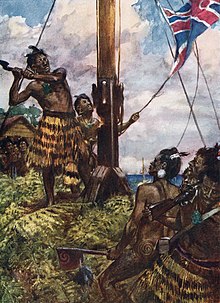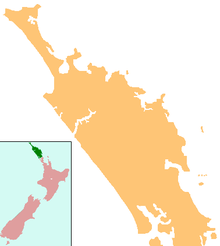| Battle of Kororāreka | |||||||
|---|---|---|---|---|---|---|---|
| Part of the Flagstaff War | |||||||
 Hōne Heke removing the British colors from Flagstaff Hill in Kororāreka | |||||||
| |||||||
| Belligerents | |||||||
|
|
| ||||||
| Commanders and leaders | |||||||
|
|
| ||||||
| Units involved | |||||||
|
| ||||||
| Strength | |||||||
|
~90 sailors & marines ~52 soldiers ~70 armed civilians | ~600 warriors | ||||||
| Casualties and losses | |||||||
|
Military (11 March) 10 killed ~22 wounded Civil (11-17 March) ~13 killed >13 wounded |
~34 killed Unknown wounded | ||||||
 | |||||||
| Flagstaff War | |
|---|---|
The Battle of Kororāreka, or the Burning of Kororāreka, on 11 March 1845, was an engagement of the Flagstaff War in New Zealand. Following the establishment of British control of the islands, war broke out with a small group of the native population which resulted in the fall of the town of Kororāreka, present day Russell, to Māori warriors.
Background
Although he had been the first to sign the Treaty of Waitangi in February 1840, Ngāpuhi chief Hōne Heke became increasingly unhappy with the outcome. He objected to the relocation of the capital to Auckland and changes to custom tariffs that caused a serious loss of revenue to the Ngāpuhi.
In July 1844, Heke and a group of warriors entered the town, and the Pakaraka chief Te Haratua cut down the flagstaff. Heke himself had set out to cut down the flagstaff, but had been persuaded by Archdeacon William Williams not to do so. Six months later on 10 January 1845 the flagstaff was cut down a second time - this time by Heke. A new and stronger flagstaff sheathed in iron was erected later that month and a guard post built around it - but the next morning the flagstaff was felled for the third time.
Governor FitzRoy sent over to New South Wales for reinforcements. A block-house and ditch, designed by Captain George Augustus Bennett, RE, was built at the base of the flagstaff, a guard of 20 soldiers was placed in this, and a fourth flagstaff erected.
Battle
On 11 March 1845 Hōne Heke and his men, along with Te Ruki Kawiti and his followers, attacked the town.
British forces were outnumbered. HM Sloop Hazard landed a party to aid the detachment of 96th Regiment commanded by Lieutenant Edward Barclay. In all there were about 140 soldiers, sailors and marines. The American sloop USS St. Louis, under Captain Isaac McKeever, USN, was also present and her crew assisted in evacuating the British subjects.
Heavy skirmishing lasted for a while until a large explosion destroyed all of the defender's reserve ammunition. The explosion also set a building on fire which spread. At about that time the British had begun to withdraw to the safety of the ships anchored in the bay and evacuate the civilian population. HMS Hazard then bombarded Māori positions.
On the day, ten military defenders and three civilians were killed in action or died of wounds. At least thirty-six were variously wounded. The town was mostly destroyed after evacuation and over the following days.
-
 Kororāreka (Russell) before the battle, 10 March 1845
Kororāreka (Russell) before the battle, 10 March 1845
-
 Kororāreka (Russell) during the battle, 11 March 1845
Kororāreka (Russell) during the battle, 11 March 1845
-
 Wood fragments said to be from the flagstaff cut down by Hōne Heke. Auckland War Memorial Museum
Wood fragments said to be from the flagstaff cut down by Hōne Heke. Auckland War Memorial Museum
-
 Russell (Kororāreka) from the bay, 24 January 2018
Russell (Kororāreka) from the bay, 24 January 2018
| Māori | Name and Identity | Action | Buried | Ref |
|---|---|---|---|---|
| Pūmuka. Rangatira, Ngāpuhi, Te Roroa, Ngāti Rangi, Ngāti Pou | Matavia Pass | |||
| Hirawanu | ||||
| Kereopa | ||||
| About 31 unidentified | ||||
| Military | ||||
| Royal Navy | James McCarthy. Colour-Sergeant, Royal Marines, HMS Hazard | Matavia Pass | Christ Church, Kororāreka, 11 March | |
| Alexander May. Private, Royal Marines, HMS Hazard | Matavia Pass | Christ Church, Kororāreka, 11 March | ||
| Whitaker Denby. Seaman, HMS Hazard | Matavia Pass | Christ Church, Kororāreka, 11 March | ||
| William Love. Seaman, HMS Hazard | Matavia Pass | Christ Church, Kororāreka, 11 March | ||
| William Lovell. Seaman, HMS Hazard | One Gun Battery, Matavia Pass | Christ Church, Kororāreka, 11 March | ||
| Frederick George Minikin. Seaman, HMS Hazard | Matavia Pass | Christ Church, Kororāreka, 11 March | ||
| British Army | William Giddens. Private, 96th Regiment | Flagstaff Blockhouse | St Paul's Church, Paihia, 12 March | |
| Henry Ireson. Private, 96th Regiment | Flagstaff Blockhouse | St Paul's Church, Paihia, 12 March | ||
| George Jackson. Private, 96th Regiment | Flagstaff Blockhouse | St Paul's Church, Paihia, 12 March | ||
| William Miller. Private, 96th Regiment | Flagstaff Blockhouse | St Paul's Church, Paihia, 12 March | ||
| James Duross. Private, 96th Regiment | Lower Blockhouse. Severe head wound. Died, Auckland, 3 April | |||
| Civil | ||||
| Government | John Thompson. Seaman, HM Colonial Brig Victoria; Police boatman | Stockade explosion. Burns
Died, HMS Hazard, 14 March |
At sea, 14 March | |
| Unidentified. Seaman, HM Colonial Brig Victoria. Possibly John Pierpoint | GSW to forehead. Possibly Pierpont, died, Auckland, 23 March | Symonds Street Cemetery, Auckland, 25 March | ||
| Civilian | Henry Torre. Commander, schooner Dolphin; solicitor | Stockade explosion. Burns
Died, HMS Hazard, 12 March |
St Paul's Church, Paihia, 12 March | |
| Fanny Wing. Daughter of Rautangi and Thomas Wing | Flagstaff Blockhouse | St Paul's Church, Paihia, 12 March | ||
| 9 unidentified | Post-battle spoils. Some bodies burnt, 11–17 March | Christ Church, Kororāreka, 11–17 March 1845 |
Memorial

Six men from the Hazard who died in the action are remembered by a grave marker at Christ Church, Russell. The last two verses of the poem England's Dead by Felicia Hemans are inscribed on the marker in memory of them:
The warlike of the isles,
The men of field and wave!
Are not the rocks their funeral piles,
The seas and shores their grave?
Go, stranger! track the deep,
Free, free the white sail spread!
Wave may not foam, nor wild wind sweep,
Where rest not England's dead.
Variation in the verses appear in visitor observations and through marker restoration since 1845.
See also
References
- ^ "The sacking of the settlement at the Bay of Islands, called Kororarika, by the natives, on the voluntary surrender thereof by the naval and British forces". The Australian. New South Wales, Australia. 8 April 1845. p. 2. Retrieved 2 January 2020.
- FitzRoy, Robert (1846). Remarks on New Zealand in February 1846. London: W. and H. White. p. 38. ISBN 9780902041134.
- ^ "Bay of Islands". The New Zealand Spectator and Cook's Strait Guardian. Vol. 1, no. 25. 29 March 1845. p. 3.
- Phillpotts, George (15 March 1845). "Kororāreka". Great Britain Parliamentary Papers: Papers Relative to New Zealand, 1845. Letter to Robert FitzRoy. London.
- ^ Carleton, Hugh (1877). The Life of Henry Williams, Archdeacon of Waimate. Vol. 2. Auckland: Wilson & Horton via Early New Zealand Books (ENZB), University of Auckland Library.
- ^ Phillpotts, George; Veitch, John Topwell (22 March 1845). "Legislative Council: H.M. Ship Hazard, Bay of Islands, March 11, 1845". The Southern Cross. Vol. 2, no. 101. p. 2.
- ^ Admiralty, Captain’s Log, HMS Hazard, 01 April 1841–6 May 1847 (The National Archives Kew, ADM 51/3613)
- ^ Barclay, Edward (22 March 1845). "Bay of Islands: H.M.S. Hazard, March 15, 1845". The Southern Cross. Vol. 2, no. 101. p. 2.
- ^ Selwyn, George Augustus (1847). "A Letter from the Bishop of New Zealand to the Society for the Propagation of the Gospel; Containing an Account of the Affray Between the Settlers and the Natives at Kororareka". Church in the Colonies, New Zealand, Part 4. 13. London: The Society for the Propagation of the Gospel – via ENZB.
- "Battle of Kororareka". Russell Museum. Archived from the original on 24 July 2011. Retrieved 23 June 2011.
- Kawiti, Tawai (October 1956). "Hekes War in the North". No. 16 Ao Hou, Te / The New World, National Library of New Zealand. p. 46. Retrieved 10 October 2012.
- Kawharu, Freda Rankin (1990). "Story: Heke Pōkai, Hōne Wiremu". Te Ara—The Encyclopedia of New Zealand; Dictionary of New Zealand Biography. Retrieved 30 November 2023."...Te Haratua, Heke's second in command, led his men to cut down the flagstaff..."
- Cowan, James (1922). "Chapter 4: The Fall of Kororareka". The New Zealand Wars and the Pioneering Period (PDF). Vol. 1. Wellington: Ministry of Internal Affairs.
- Colledge, J. J.; Ben Warlow (2006). Ships of the Royal Navy: The Complete Record of all Fighting Ships of the Royal Navy. London: Chatham University. p. 159. ISBN 978-1-86176-281-8. OCLC 67375475.
- ^ HTF (20 October 1885). "Some Obscure Naval Heroes". Sydney Morning Herald. New South Wales. Retrieved 31 December 2019.
- Dewhirst, Jonathan (2016), "The Flagstaff War, Bay of Islands, New Zealand, 1845", Britain's Small Forgotten Wars, retrieved 31 December 2019
- "Copies or Extracts of Correspondence Relative to an Attack on the British Settlement at the Bay of Islands by the Natives of New Zealand", Accounts and Papers of the House of Commons: Papers Relative to the Affairs of New Zealand, vol. 33, pp. 18–19, 1845
- "Domestic". Auckland Times. Vol. 3, no. 117. 8 April 1845.
- "New Zealand Domestic News". The Courier (Hobart). Vol. 18, no. 1052. 10 May 1845. p. 4 – via Trove.
- "James Duross". Online Cenotaph. Auckland War Memorial Museum. Retrieved 26 March 2023.
- Log Book of the Government Brig Victoria, 1843 to 1845 – via Auckland Libraries
- "Cemetery Records: Pierpont, -, d.1845; Reipont, -". Auckland Libraries Heritage Collections SSC-7177. Auckland: Auckland Libraries.
- Davis, C G (15 July 1845). "Death of Mr Henry Torre". Letter to Cobb. Plymouth.
- Byrne, T B, "'Wing, Thomas', Dictionary of New Zealand Biography, first published in 1990", Te Ara—The Encyclopedia of New Zealand, retrieved 1 January 2020
- "Bay of Islands". New Zealand Spectator and Cook's Strait Guardian. Vol. 1, no. 29. 26 April 1845. p. 3.
- "Bay of Islands". The Southern Cross. Vol. 2, no. 101. 22 March 1845. p. 2.
- "Kororāreka residents NZ Wars memorial".
- Hemans, Felicia Dorothea Browne (1839). The Works of Mrs. Hemans; with a Memoir of Her Life. Vol. 5. Edinburgh: William Blackwood & Sons. pp. 127–129.
- King, Marie Menary (1992). A Most Noble Anchorage: A Story of Russell and the Bay of Islands. Northland Historical Publications Society. Archived from the original on 5 October 2012. Retrieved 18 June 2011.
- Wearne, R T (1 March 1958). "New Zealand's Old Church Curiosities". Walkabout. Vol. 24, no. 3. Australian National Travel Association. pp. 38–41 – via National Library of Australia.
- Morris, Edward Ellis (1890). Cassell's picturesque Australasia. Vol. 4. Cassell & Company. p. 125.
- The Vagabond (3 May 1890). "In New Zealand". The Age. No. 10979. Victoria, Australia. p. 4. Retrieved 28 February 2021 – via National Library of Australia.
- "Auckland, New Zealand: A Cruise in the Local Steamer". The Sydney Morning Herald. Vol. 37, no. 5614. New South Wales, Australia. 6 May 1856. p. 2. Retrieved 28 February 2021 – via National Library of Australia.